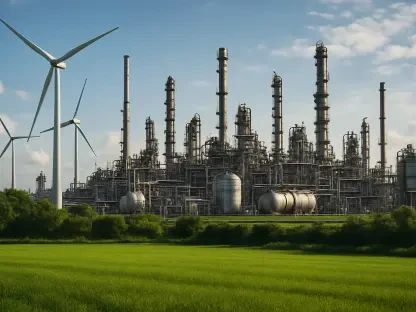The recent decisions by major oil companies have garnered significant attention as the landscape of the energy sector undergoes a remarkable transformation. Companies like BP are adjusting their strategies with a renewed emphasis on traditional fossil fuels amid challenges associated with renewable energy investments. This shift highlights the ongoing complexities in the energy industry, as financial stability increasingly becomes the decisive factor for many supermajors. The intricate dynamics at play reveal a compelling narrative about how companies balance their ambitions for sustainability with financial pragmatism, driven by both geopolitical factors and evolving market conditions.
BP’s Retreat from Renewables
Strategic Withdrawal from Onshore Wind in the U.S.
BP’s decision to divest its 1.3-gigawatt onshore wind power portfolio in the United States marks a significant departure from its renewable energy investments. This move underlines a broader industry trend where major oil companies reevaluate their commitments to non-conventional energy sources. Financial pressures, policy shifts, and geopolitical uncertainties are pivotal in shaping these strategic decisions. For BP, exiting the onshore wind business reflects its prioritization to rationalize its asset base, emphasizing sectors that ensure robust financial returns, thus allowing it to capitalize on core competencies. This recalibration by BP illustrates a pragmatic approach, focusing on profitability and sustainability within a volatile economic landscape.
Political Influences and Market Realities
The political landscape significantly influences the viability of renewable energy projects, contributing to the reevaluation of strategies by companies like BP. During recent political tenures in the United States, policies have created a less favorable environment for wind power and other renewables. This environment has further complicated the financial landscape for wind and solar projects, increasing their susceptibility to financial uncertainties and diminishing incentives. Consequently, these shifts have led many industry giants to reassess the sustainability of their renewable ventures. This reassessment is not only a response to political pressures but also a reflection of the industry’s adaptation in balancing market-driven realities with aspirations of transitioning toward a greener future.
Financial Realities of Renewable Ventures
Subsidies and Profitability Challenges
Investments in renewable energy, especially those heavily dependent on subsidies, are facing heightened scrutiny due to profitability challenges. The expiration of government incentives for wind and solar projects has redefined the economic landscape, prompting companies to reevaluate their positions. Reports indicate that numerous renewable ventures are at risk as subsidies dwindle, highlighting the pressing need for innovative approaches to achieve cost efficiency. For companies like BP, whose initial enthusiasm for renewable energy investments has waned, the challenges associated with profitability have fostered a strategic shift. This shift emphasizes consolidating operations within sectors that promise a steadier financial return, reaffirming a reliance on traditional oil and gas endeavors.
The Appeal of Reliable Revenue Streams
Revisiting the historical strength of oil and gas businesses serves as a strategic realignment for supermajors seeking financial stability amid uncertain renewable energy ventures. Despite efforts to diversify portfolios and invest in new technologies, the appeal of time-tested revenue streams remains strong. Companies like BP are strategically aligning with familiar sectors offering both economic security and proven profitability. This return is not merely a retreat from innovation but rather a calculated adaptation to maintain a competitive edge. By reinvesting in oil and gas capabilities, supermajors effectively capitalize on known revenue drivers, balancing their portfolio amid uncertain financial landscapes shaped by the evolving nature of energy demands.
Navigating Future Energy Strategies
Balancing Diversification and Profitability
While the ambition to transition from Big Oil to Big Power continues to drive industry narratives, financial realities prompt a reevaluation of renewable investments. Diversification into low-carbon technologies and carbon capture has been a conscientious effort by many companies. However, as projects face profitability challenges, a strategic recalibration is vital. Companies must weigh their aspirations for sustainability against achieving profitable returns. This requires innovative strategies to generate cost efficiencies and enhance the sustainability of future energy endeavors. Moving forward, energy sector leaders must pursue balanced diversification strategies, ensuring that financial objectives align with long-term commitments to cleaner energy production, creating opportunities for enduring industry sustainability.
Innovation and Technological Advancements
Recently, decisions made by major oil companies have captured significant attention as the energy sector experiences a transformative shift. Companies such as BP are readjusting their strategies to place a greater emphasis on traditional fossil fuels. This comes as they face challenges with their investments in renewable energy, revealing the complexities of the industry. These shifts underscore how financial stability is becoming the key factor for many supermajors as they navigate the energy landscape. The narrative unfolding in this scenario is compelling, demonstrating how oil companies balance ambitions for a sustainable future with the need for financial prudence. Geopolitical factors, alongside evolving market conditions, play a crucial role. These factors are pushing companies to carefully weigh their sustainable goals against immediate economic demands. The energy sector’s dynamics show an intricate dance between innovation and the reality of market pressures, illustrating the delicate interplay of long-term vision and current financial imperatives.









